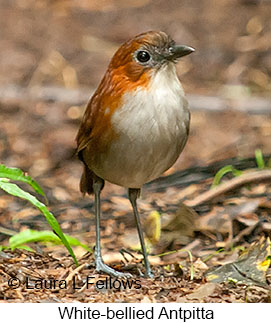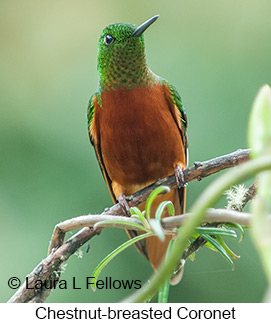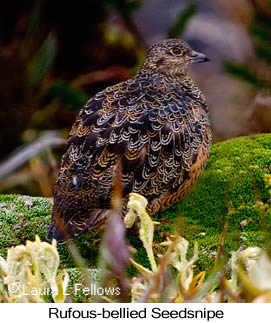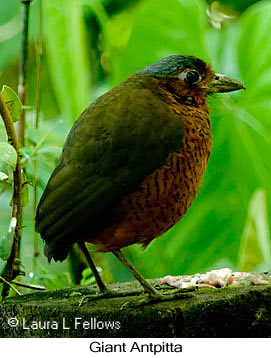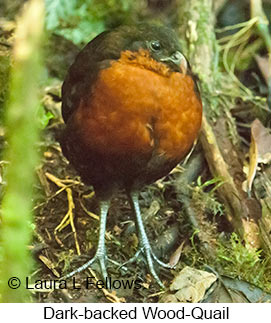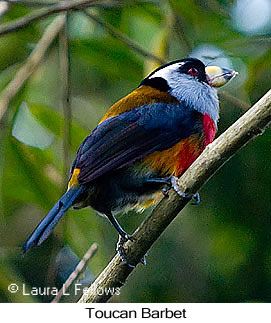2018 NORTHERN ANDES BIRD PHOTO TOUR
Tour Description

ECUADOR
PHOTO TOUR
May 23-Jun 1, 2018
| Duration: | 10 days, 9 nights |
| Group Size: | 2-8 |
| Anytime Price: | $3375 |
| Group Price: | $2975 |
| Single Suppl: | $250 |
| Pace: | Easy/Moderate |
| Difficulty: | Easy/Moderate |
DAY 1 - QUITO
International flights arrive by evening. Hotel provides transfer to accommodations. Night at Wyndham Airport Hotel.
DAY 2 - SAN ISIDRO RESERVE
Early transfer to San Isidro Lodge, a middle elevation site downslope from Papallacta. En route take a side road up to the antenna area above Papallacta Pass to look especially for Rufous-bellied Seedsnipe. This area is one of the few places in Ecuador where it can be seen. Other likely high elevation birds there include Stout-billed Cinclodes, Chestnut-winged Cinclodes, Many-striped Canastero, and Plain-capped Ground-Tyrant. Always possible, though rare, is an Andean Condor soaring above the valley below. After arrival at San Isidro, bird paths around the lodge grounds. The grounds near the dining area and cabanas have paved and stone paths through gardens and forest edge. These offer very good opportunities to find Masked Trogon, tanagers, and flycatchers. Shortly after dark look for the mysterious "San Isidro Owl", a bird intermediate in plumage between Black-and-white Owl and Black-banded Owl. No one quite knows what this owl is. It may be a separate species or a sub-species new to science. The owl is usually present and easily seen around the lodge walkways. Night at Cabanas San Isidro.
DAY 3 - LORETO ROAD & SAN ISIDRO
Most of day bird famed upper Loreto Road, an altitudinal transect from temperate forest into subtropical forest. Temperate forest along the upper Loreto Road is home to a great diversity of birds including White-eyed Parakeet, the endemic Coppery-chested Jacamar, Dark-breasted Spinetail, Lined Antshrike, Short-billed Chlorospingus, Bronze-green Euphonia, Orange-eared Tanager, Spotted Tanager, Caqueta Seedeater, and Golden-eyed Flowerpiercer. Farther downslope is the upper subtropical zone near the junction with the Archidona Road and the lower Loreto Road. Also bird part of the lower Loreto Road or a short stretch of the Archidona Road. It's worth checking the roadside edge habitat and the more open agricultural area. Possibilities along the lower Loreto Road include the rare Amazonian Umbrellabird and many species of flycatchers and subtropical tanagers such as Paradise Tanager. The Archidona Road passes through an agricultural area and can produce Gilded Barbet, Yellow-tufted Woodpecker, and Orange-backed Troupial. Night at Cabanas San Isidro.
DAY 4 - SAN ISIDRO
Early morning will be devoted to seeing antpittas that can usually be lured onto a trail not far from the dining room include Two species usually appear, Chestnut-crowned Antpitta and White-bellied Antpitta. The remainder of the morning will be spent birding the San Isidro Reserve, private property owned by the lodge. Several trails go through secondary forest, where it's sometimes possible to see Crested Quetzal. Also possible is Golden-headed Quetzal. Among the other birds that could be found in the forest and along forest edge are Andean Motmot, Crimson-mantled Woodpecker, Orange-eared Tanager, Golden-naped Tanager, Blue-necked Tanager, and Beryl-spangled Tanager. Hummingbirds are present at feeders near the dining room, including Tawny-bellied Hermit, Bronzy Inca, Green-fronted Lancebill, Violet-bellied Hummingbird, and Fawn-breasted Brilliant. After lunch transfer to Guango Lodge. Remainder of afternoon view hummingbirds around Guango Lodge. The hummingbird feeders just outside the dining room are a major attraction at the lodge. Up to 15 species of hummingbirds vie for perches and feeding stations. Species typically present are Sparkling Violetear, Buff-tailed Coronet, Chestnut-breasted Coronet, Mountain Velvetbreast, Collared Inca, Buff-winged Starfrontlet, Sword-billed Hummingbird, Tourmaline Sunangel, Glowing Puffleg, Purple-backed Thornbill, Tyrian Metaltail, Mountain Avocetbill, Long-tailed Sylph, White-bellied Woodstar, and Gorgeted Woodstar. Night at Guango Lodge.
DAY 5 - GUANGO RESERVE & TANDAYAPA
Morning birding at Guango Lodge and reserve. The path through the gardens offers superb birding, especially during early morning. The path is basically a grassy area surrounded by gardens and secondary growth along the river. There is also some forest edge where forest species often appear. Torrent Duck and White-capped Dipper are sometimes found along the river, and birds such as Black-capped Hemispingus, Black-eared Hemispingus, Gray-hooded Bush Tanager, Hooded Mountain-Tanager, Lacrimose Mountain-Tanager, Blue-and-black Tanager, Capped Conebill, Masked Flowerpiercer, and Slaty Brush-Finch can often be found in the gardens. After early lunch, depart for the western Andes and Tandayapa Bird Lodge. After arrival and check-in, view hummingbirds at the many feeders behind the lodge restaurant. Some of the notable species are Violet-tailed Sylph, Buff-tailed Coronet, Booted Racket-tail, White-bellied Woodstar, Western Emerald, and Andean Emerald. Night at Tandayapa Bird Lodge.
DAY 6 - TANDAYAPA & MINDO
All morning bird around the lodge. Tandayapa Bird Lodge owns some forest property that offers excellent birding. A trail winds uphill and downhill around a gully, ending up on the road below the lodge. Birding along that trail and on side trails that lead farther uphill can be superb. A blind near the lodge is worth visiting in early morning. A number of secretive species such as Giant Antpitta, Scaled Antpitta, and Rufous-breasted Antthrush sometimes show up there. Many visitors never walk the trails, but they are worth the effort especially in early morning. Among the many attractions are Golden-headed Quetzal, Crimson-mantled Woodpecker, Powerful Woodpecker, Golden-winged Manakin, the endemic Ecuadorian Thrush, Blue-capped Tanager, Flame-faced Tanager, and Beryl-spangled Tanager. Of special note is the endemic Beautiful Jay, which is often seen on the far side of the ravine across from the lodge by those who do the entire loop trail.
After early lunch, depart for Milpe Bird Sanctuary downslope from Mindo. On the way there, stop at a cafe outside Los Blancos where hummingbird and fruit feeders attract a nice variety of hummingbirds and tanagers. Milpe is a small reserve that offers superb birding and features a variety of species not found at higher elevation Mindo. Several wide easy trails provide access to middle elevation forest, while hummingbird feeders in the open gardens attract a variety of hummingbirds. Birds of interest include the beautiful endemic Choco Toucan, Blue-tailed Trogon, Collared Trogon, the near endemic Guayaquil Woodpecker, Esmeraldas Antbird, Pacific Flatbill, Orange-crested Flycatcher, and various tanagers including Tawny-crested Tanager, Moss-backed Tanager, Glistening-green Tanager, Gray-and-gold Tanager, and Ochre-breasted Tanager. It's also an excellent place to look for the rare Tooth-billed Hummingbird. Night at Hosteria Septimo Paraiso.
DAY 7 - REFUGIO PAZ & BELLAVISTA RESERVE
Extremely early departure for half hour drive to Refugio Paz, where the owner has conditioned several species of antpittas to come out on the trail for food. Following a 20-minute hike down a somewhat steep trail, we'll reach a blind where we can observe male Andean Cocks-of-the-Rock displaying in the understory. Later Angel Paz will treat us to close-up views of extremely rare and locally distributed antpittas he has conditioned to come out onto the trail. Species that usually appear are Giant Antpitta and Yellow-breasted Antpitta. Less commonly, the very shy Moustached Antpitta also puts in an appearance. More recently, Angel has also conditioned Ochre-breasted Antpitta to appear as well. In addition to the antpittas, Angel can sometimes lure the rare and secretive Dark-backed Wood-Quail into the open as well. Many other middle elevation specialties are seen regularly during a visit to this private reserve, including Golden-headed Quetzal, Toucan Barbet, Ecuadorian Thrush, Flame-faced Tanager, and Black-capped Tanager. Angel also has several hummingbird feeders that attract hummingbirds similar to those at Tandayapa Bird Lodge and Septimo Paraiso.
Afternoon transfer to Bellavista Cloud Forest Reserve, located at higher elevation than Mindo or Tandayapa on a ridgeline between the two valleys. Everyone is likely to be rather tired from the early visit to Refugio Paz, so there will be time to rest and relax. Bellavista Lodge is the perfect place to do that. One can sit on the veranda outside the restaurant, enjoy a drink, and watch birds in the surrounding trees. Toucan Barbet, Green-and-black Fruiteater Barbet, and Plate-billed Mountain-Toucan regularly put in an appearance, along with a variety of other birds. Night at Bellavista Cloud Forest Lodge.
DAY 8 - BELLAVISTA RESERVE
Bellavista is located on a ridgeline so many of the trails are rather steep and difficult. However, a few trails traverse the ridgeline through secondary forest and are worth birding. Morning birding in the forest can produce Sickle-winged Guan, Crimson-mantled Woodpecker, Sierran Elaenia, Smoke-colored Pewee, Turquoise Jay, and White-sided Flowerpiercer. Numerous hummingbird feeders draw in a variety of species, mostly similar to those seen in Mindo and Tandayapa Valleys. All day will be spent birding there. Night at Bellavista Cloud Forest Lodge.
DAY 9 - BELLAVISTA & TRANSFER
Much of day view and photograph birds around the lodge. After lunch transfer to Quito, arriving at the hotel before dark. Night at Wyndham Airport Hotel.
DAY 10 - END OF TOUR
Tour ends with breakfast at the hotel. International flights home.
ADDITIONAL INFO
(Not on Menu Above)
TOUR LOCALES
